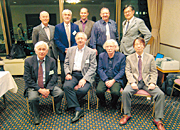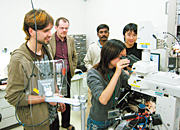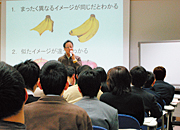Outcome of the Cognitive Brain Science Group Review
November 2006, the Cognitive Brain Science Group (directed by Dr. Keiji Tanaka) underwent a research review. The nine-member review committee, chaired by Prof. Michael P. Stryker from the University of California, evaluated the output of group as well as the research in each of its laboratories.
Two laboratories in this group conduct experiments using human and non-human primate subjects focusing on visual object recognition and decision-making.
These labs are the Laboratory for Cognitive Brain Mapping, headed by Dr. Keiji Tanaka, and the Laboratory for Integrative Neural Systems, headed by Dr. Manabu Tanifuji. The laboratory for Human Brain Dynamics, led by Dr. Andreas A. Ioannides, explore human brain function using magnetoencephalography (MEG), and Dr. Kathleen S. Rockland’s laboratory, called the Laboratory for Cortical Organization and Systematics, studies the anatomical structure of higher brain regions associated with function. There is also a research support unit to assist in fMRI research with human subjects.
As one of the research groups in the world focusing on higher brain functions, the findings of these laboratories are widely cited for their contributions in object recognition by neuroscience, psychology, and computer science departments at universities throughout the world. In addition, the measurement and analysis techniques used in some of these labs are highly productive and wonderfully creative in terms of how these technologies are used and how the experiments are developed using these tools.
Established in the hopes of that by employing various experimentation techniques, the laboratories in this group would work together to pursue research goals, the group has successfully explored synergies in the study of object recognition in the cortex of the inferior temporal lobe and fMRI investigations. Projects that combine fMRI and MEG, however, remain limited and the relationship between the functional structure and anatomy in the cortex could be more comprehensively defined.
The creation of the fMRI Support Unit last October should encourage more interdisciplinary research at BSI.
IBRO APRC/RIKEN BSI Advanced School
The IBRO APRC/RIKEN BSI Advanced School was held from February 26 to March 9, 2007. This was the first advanced school activity organized by IBRO APRC (International Brain Research Organization, Asia Pacific Region Committee) to provide post-doctorate and promising young researchers based in the AP region with the opportunity to pursue more advanced intellectual experiences and research. APRC selected BSI to host the Advanced School. Eleven participants heard lectures given by BSI laboratory heads and Dr. Esther Atockli (Institute of Zoology, University of Zurich, Switzerland) in the morning and worked in laboratories to gain practical experience after lectures that let participants use many of BSI’s technologies.
World Brain Awareness Week 2007
As a part of a worldwide campaign to promote the social significance of brain science, various institutes and venues throughout Japan hosted events as part of World Brain Awareness Week 2007 from March 12 to 18, 2007. BSI invited more than one hundred high-school students and teachers to participate in a symposium and lab tour on March 17, 2007. This event was called “Uncovering the mysteries of brain” and Special Advisor Dr. Masao Ito gave the opening address. Dr. Manabu Tanifuji lectured on the brain mechanisms for object recognition and Dr. Tadaharu Tsumoto spoke about brain development. Participants then visited two of the eight laboratories open for tours. Students and teachers asked many interesting questions, enjoying the opportunity to deepen their understanding of brain science.
RIKEN BSI and Oxford-Kobe Joint International Symposium
On April 14-17, 2007, for the second time in three years, leading researchers on dyslexia came to The Kobe Institute in Japan to discuss the latest developments in reading disorders across languages. This symposium, jointly supported by RIKEN Brain Science Institute and Oxford University, brought together scientists from nine nations, including Japan and the United Kingdom for twenty-five lectures and three poster sessions.
Three investigators attended from BSI. Reiko Mazuka showed that the reading of kanji characters in Japanese is influenced by phonological characteristics of kanji, such as the number of mora needed to pronounce the word, orthographic transparency, and typicality of orthography. Kazuo Okanoya and his group presented evoked brain response data and suggested that there are common underlying mechanisms in auditory and visual segmentation of continuous stimuli.
Finally, Cees van Leeuwen introduced a new hypothesis linking learned perceptual strategies to reading success. Their outsiders’ perspectives stirred participants’ interests and sparked engaged discussion on the causes and mechanisms of dyslexia.
RIKEN Open Day 2007
On April 21, 2007, RIKEN Wako Institute opened its campus to the public once again. BSI welcomed families and groups of students and invited them to learn about the brain at through interactive exhibits or by talking with researchers. Through these activities, visitors were able to appreciate the processes through which of brain science strives to understand the brain.
RIKEN BSI's 10th anniversary
RIKEN BSI will mark its 10th anniversary with a series of events scheduled between June and October 2007. The official website provides more detail: www.noukagaku10.jp








